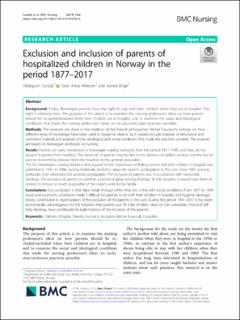| dc.contributor.author | Sundal, Hildegunn | |
| dc.contributor.author | Petersen, Karin Anna | |
| dc.contributor.author | Boge, Jeanne Helene | |
| dc.date.accessioned | 2022-11-03T12:32:17Z | |
| dc.date.available | 2022-11-03T12:32:17Z | |
| dc.date.created | 2019-03-08T15:41:53Z | |
| dc.date.issued | 2019 | |
| dc.identifier.citation | BMC Nursing. 2019, 18 (6), 1-11. | en_US |
| dc.identifier.issn | 1472-6955 | |
| dc.identifier.uri | https://hdl.handle.net/11250/3029894 | |
| dc.description.abstract | Background: Today, Norwegian parents have the right to stay with their children when they are in hospital. This right is relatively new. The purpose of this article is to examine the nursing profession’s ideas on how parents should be included/excluded when their children are in hospital, and to examine the social and ideological conditions that made the nursing profession’s ideas on inclusion/exclusion practices possible. Methods: The analyses are done in the tradition of the French philosopher Michel Foucault’s writings on how different kinds of knowledge have been used to discipline citizens. Such studies include analyses of descriptive and normative material and analyses of the ideological and social conditions that made the practices possible. The analyses are based on Norwegian textbooks on nursing. Results: Parents are rarely mentioned in Norwegian nursing textbooks from the period 1877–1940, and they are not present in photos from hospitals. The exclusion of parents may be due to the absence of welfare services and the fear of parents transmitting diseases from the hospitals to the general population. The first Norwegian nursing textbook that argued for the importance of letting parents visit their children in hospital was published in 1941. In 1968, nursing textbooks started to argue for parents’ participation in the care. Since 1987, nursing textbooks have advocated full parental participation. The inclusion of parents was in accordance with humanistic ideology. The inclusion of parents occurred in a period of great nursing shortage. In this situation, it would have been of interest to entrust as much as possible of the nurse’s work to the family. Conclusions: Our conclusion is that ideas break through when they are in line with social conditions. From 1877 to 1940 social and economic conditions made it difficult for parents to be with their children in hospital, and hygiene ideology/theory contributed to legitimization of the exclusion of the parents in the care. During the period 1941–2017 it has been economically advantageous for the hospitals that parents care for their children. Ideas on the vulnerable child and self-help ideology have contributed to legitimization of the inclusion of the parents. Keywords: children, hospital, parents, exclusion, inclusion, Michel Foucault, discipline | en_US |
| dc.language.iso | eng | en_US |
| dc.relation.uri | https://doi.org/10.1186/s12912-019-0330-6 | |
| dc.rights | Navngivelse 4.0 Internasjonal | * |
| dc.rights.uri | http://creativecommons.org/licenses/by/4.0/deed.no | * |
| dc.title | Exclusion and inclusion of parents of hospitalized children in Norway in the period 1877–2017 | en_US |
| dc.type | Peer reviewed | en_US |
| dc.type | Journal article | en_US |
| dc.description.version | publishedVersion | en_US |
| dc.source.pagenumber | 1-11 | en_US |
| dc.source.volume | 18 | en_US |
| dc.source.journal | BMC Nursing | en_US |
| dc.source.issue | 6 | en_US |
| dc.identifier.doi | 10.1186/s12912-019-0330-6 | |
| dc.identifier.cristin | 1683372 | |
| cristin.unitcode | 211,2,0,0 | |
| cristin.unitname | Avdeling for helse- og sosialfag | |
| cristin.ispublished | true | |
| cristin.fulltext | original | |
| cristin.qualitycode | 1 | |

